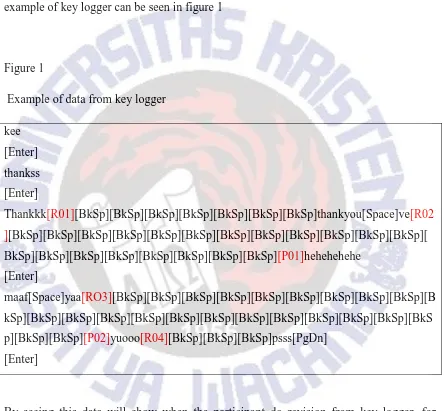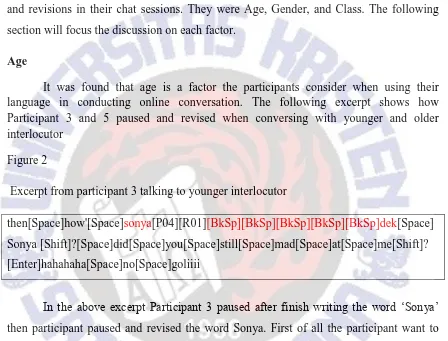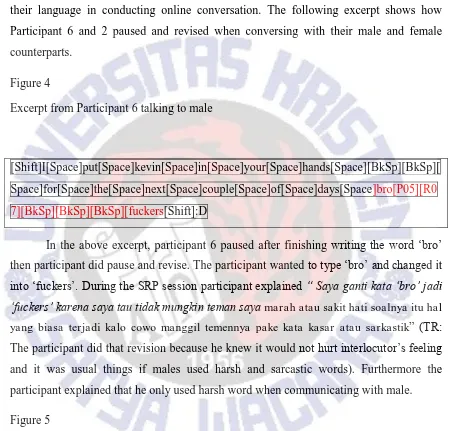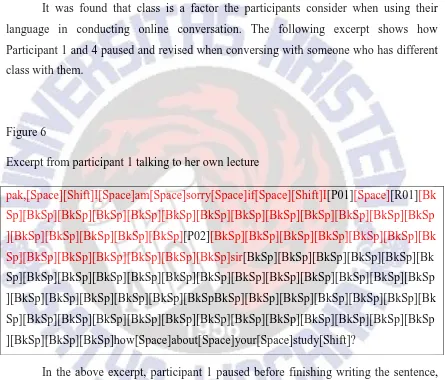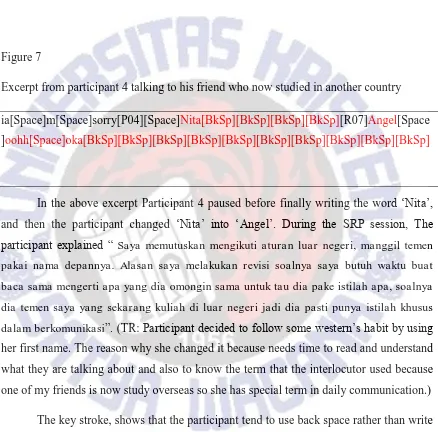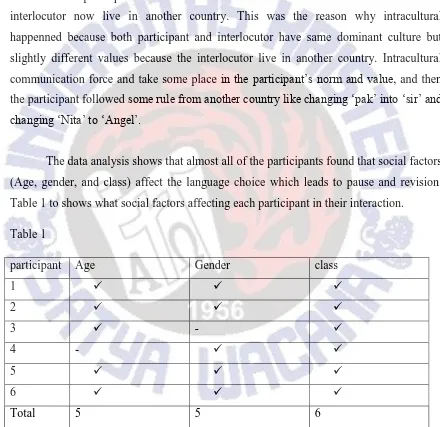Introduction
Conversations are rhythmic in nature, and the rhythms of conversation have long attracted the attention of diverse communication researchers (Brady, 1965; Cappella, 1979; Jaffe & Feldstein, 1970; Sacks, Schegloff, & Jefferson, 1978 in Kalman, 2006). An on-off pattern determines the rhythm of a conversation, and the pauses or gaps in speech that constitute that pattern have been investigated in depth under various names, including pause, gap, and silence (McLaughlin, 1984 in Kalman, 2006). Historically, the needs for the internet as the medium for communication have been started since the emergence of email in the beginning of 1990s (Sumakul, 2011). Since the era of the internet, the amount of users is increasing every year, even every day. Furthermore internet has become a media for communicating with others. All technology has been used to communicate, from chatting, emailing, browsing, etc.
In speaking when people process the language in their brain, this could be signaled or observed by looking at pauses and hesitation or silence in speaking. This can also be observed in online communication. There are many rationalism why people tend to do pause and revision when doing CMC. Pauses and silences are an integral component of computer-mediated communication (CMC) (Tannen & Saville-Troike, 1985).Since context is important in conversation, it is also important to know why people do pauses and revision in CMC to help explain the context of the CMC communication. In this research, social factors will be investigated by observing the language choice that being used in pause and revision when doing CMC. This study was conducted to answer the research question, "What are the social factors affecting the pause and revision in CMC?
Theoretical Framework
Social Factors in Communication
As we all know, human is social creature. People need to interact with each other, whether it is face to face or using media. It is no secret that people nowadays tend to use media for their communication tool. The reason is because it is really easy to do it and we can do it whenever and wherever we want. Technology nowadays also support communication through media such us mobile phone, computer, even tab, but not many people realize when they are communicate with others, they do not aware of that social factors effecting the way they communicate. For example when talking or chatting with older people, they use polite language and with their peer, they will use emoticon, slang, and harsh words. According to Hymes (1974), when speaking, people will use some kind of method or strategy that might be helpful, which are:
S. The first letter ("S") designates Situation, which includes both the scene and the setting. This is where the activities are talking place and the overall scene in which they are a part.
E. Next, the Ends or goals of communication.
A. Acts, or speech acts include both form and content. That is, any action can be considered a communicative action if it conveys meaning to the participants.
K. One can also choose to focus upon the Key or tone of speech. How the speech sounds or was delivered.
I. Instrumentality or the channel through which communication flows can be examined. N. The Norms of communication or the rules guiding talk and its interpretation can reveal meaning.
G. Finally, one can look at cultural or traditional speech Genres, such as proverbs, apologies, prayers, small talk, problem talk, etc.
communicate to another female in a long period time. This is the reason why gender also has a big impact in communication. According to (Crosby, Faye and Nyquist, 1977) males‟ language is considered to be more adult and assertive, and females‟ language is hyper-polite and commonly non-assertive. The last social factor that we need to talk about is class. Actually there are many examples of class factors. For example, when people talk to their boss, they will use formal language, and when student talk to their own lecturer they will use formal language. This is why class also has significance impact in how people communicate with others.
using one language. Furthermore Allwood categorized into four sections that tells intercultural communication might be happen, there are:
1. Patterns of thought – common ways of thinking, where thinking includes factual beliefs, values, norms, and emotional attitudes.
2. Patterns of behavior – common ways of behaving, from ways of speaking to ways of conducting commerce and industry, where the behavior can be intentional/unintentional, aware/unaware or individual/interactive.
3. Patterns of artifacts – common ways of manufacturing and using material things, from pens to houses (artifact = artificial object), where artifacts include dwellings, tools, machines or media. The artifactual dimension of culture is usually given special attention in museums.
4. Imprints in nature – the longlasting imprints left by a group in the natural surroundings, where such imprints include agriculture, trash, roads or intact/ruined human habitations. In fact, “culture” in the sense of “growth” (i.e. a human
transformation of nature) gives us a basic understanding of what the concept of culture is all about.
From all of these researcher‟s point of view, it shows that social factors have a big impact in communication because before we communicate our brain process something about our hearer, like gender, age, status, etc. This research will emphasize on the social factors that affect pause in revision on CMC, because it is really important to look at social factors especially when the language users produce cognitive process and creating product in their brain. The move from the „language of CMC‟ to computer-mediated discourse (Herring, 2004 in Androutsopoulos, 2006) has important implications for the theory and methodology of CMC research from a sociolinguistic viewpoint. Furthermore through CMC, we can see how social factors can affect the way people communicate in online communication by looking at the language choice that the participant makes when communicate with others.
CMC: A New Mode in Communication
Warschauer (1997) mentions that since the era of the internet, the rate of human interaction through text-based form has been increased. Trunk (2009) explains that young people now write more, particularly on internet sites. CMC is a new way to communicate through internet. CMC is defined as the direct use of computers in a text-based communication processes (Miller & Sullivan, 2006:2 in Sumakul, 2012). CMC comes in two different modes, synchronous and asynchronous (Hyland, 2003). Synchronous writing occurs when people interact in real time, such as chats, while asynchronous writing occurs when people communicate in delayed way, such as emails (Sumakul, 2011).CMC can be used for complex communication such as problem-solving and decision-making, and that the outcome is qualitatively equal to FtF communication (Adrianson & Hjelmquist, 1999).This is the reason why CMC have important role in developing individual or groups skills through internet.
that speaking and writing have their own validity. According to Chafe (1987), language in its written form can be collected, stored, examined, manipulated and analyzed in ways that were until very recently impossible,for spoken language. Lingley (2005) also said that written texts may be neatly categorized as planned, organized, and transactional while spoken communication is often presented as unplanned, less structured and interactive in nature. However, features of written language can easily be found in spoken language just as written texts can exhibit aspects of conversation (Lingley, 2005). Interestingly, by communicating through CMC, people can do spoken and written language at the same time, then make spoken and written language became a part in CMC. Spoken and written and CMC become an important media for communication nowadays because spoken and written language integral with CMC. Furthermore, one of the features from CMC is pause and revision. So, by doing CMC, we can observe what happen when people do pause and revision, which might be caused by social factors.
Looking For Social Factors in CMC: Pauses and Revisions
The Study
Context of study
Internet communication is common nowadays considering people can do online communication everywhere and anytime. By analyzing chats conversation, focusing in pauses and revisions, this study wanted to investigate the social factors affecting language choice in CMC interaction. The CMC interaction in here, takes place in online communication. This research will be done in qualitative research. Qualitative research aims to addressing questions concerned with developing an- understanding of the meaning and experience dimensions of humans‟ lives and social worlds (Fossey, 2002). Qualitative research has been described as the type of research that relies on verbal description (Perry, 2011: 79), and the data will be recorded and then the participants will be interviewed, after that the data will be obtain.
Participants
Research instrument
This research will use SRP (Stimulated Recall Protocol) or common term named verbal protocol. SRP has been widely used in second language research and has been generally described under introspection terminology (Gass & Mackey, 2000 in Sumakul, 2011). This was achieved by asking speakers to report those thought after they have completed a task or activity (Gass & Mackey, 2000 in Jimenez, 2007).
Moreover, there were two softwares used in this study: 1. Cam Studio (Version 2.7.1)
In the SRP sessions, Cam studio was used to record the activity that the participant did when chatting. All the activities in the monitor were recorded by this software. An example of video image from cam studio is as shown in image 1.
Image 1
2. Actual spy key logger (Version 2.9)
This software was used is used to capture the keystroke during the chat sessions. The record of the keystroke was used to represent the video in this writing report. An example of key logger can be seen in figure 1
Figure 1
Example of data from key logger
kee [Enter] thankss [Enter]
Thankkk[R01][BkSp][BkSp][BkSp][BkSp][BkSp][BkSp][BkSp]thankyou[Space]ve[R02 ][BkSp][BkSp][BkSp][BkSp][BkSp][BkSp][BkSp][BkSp][BkSp][BkSp][BkSp][BkSp][ BkSp][BkSp][BkSp][BkSp][BkSp][BkSp][BkSp][BkSp][P01]hehehehehe
[Enter]
maaf[Space]yaa[RO3][BkSp][BkSp][BkSp][BkSp][BkSp][BkSp][BkSp][BkSp][BkSp][B kSp][BkSp][BkSp][BkSp][BkSp][BkSp][BkSp][BkSp][BkSp][BkSp][BkSp][BkSp][BkS p][BkSp][BkSp][P02]yuooo[R04][BkSp][BkSp][BkSp]psss[PgDn]
[Enter]
Data Collection
SRP involved interviewing the participants. SRP was conducted immediately after the chat sessions because the effectiveness of SRP “can be greatly affected by the temporal proximity of the recall to the original task” (Gass, 2001: 221 in Jimenez, 2007). First step is I asked the participants to conduct an online chat and recorded them using Cam Studio for about 15-20 minutes. This method was adapted from Liu and Lu (2008), when the videos were used for the SRP sessions to reveal the strategies during writing. After they finished chatting I showed them the Video recorded by Cam Studio and watched the video with the participants. While watching the video, the participants were interviewed on the reasons for the pauses on revisions they did during their chats. Their answers were then recorded and later transcribed.
Data Analysis
The analysis were based on the data from the chats, focusing on pauses and revisions. These pauses and revisions were confirmed with the reasons given by the participants during the SRP interview. The data from chats and interviews were later analysed using the theories discussed in Theoretical Framework section.
FINDINGS AND DISCUSSION
This study found that there were 3 social factors affecting the participants‟ pauses and revisions in their chat sessions. They were Age, Gender, and Class. The following section will focus the discussion on each factor.
Age
It was found that age is a factor the participants consider when using their language in conducting online conversation. The following excerpt shows how Participant 3 and 5 paused and revised when conversing with younger and older interlocutor
Figure 2
Excerpt from participant 3 talking to younger interlocutor
then[Space]how'[Space]sonya[P04][R01][BkSp][BkSp][BkSp][BkSp][BkSp]dek[Space] Sonya [Shift]?[Space]did[Space]you[Space]still[Space]mad[Space]at[Space]me[Shift]? [Enter]hahahaha[Space]no[Space]goliiii
In the above excerpt Participant 3 paused after finish writing the word „Sonya‟ then participant paused and revised the word Sonya. First of all the participant want to write „Sonya‟ then she paused and do revised by changing it into „dek Sonya‟. During the SRP session participant explained” Saya baru tau kalau teman saya lebih muda dari saya, jadi saya memutuskan memakai dek karena saya tidak terlalu dekat denganya”
(TR: The participant realized that she was talking with someone who younger than the participant, so participant use ‟dek‟ because she not really closes with the interlocutor so she decided to use „dek‟).
Figure 3
Brandon[R01][BkSp][BkSp][BkSp][BkSp][P01][BkSp][BkSp][BkSp][BkSp][BkSp][Bk Sp][P02][BkSp][BkSp][BkSp][BkSp][BkSp][BkSp][BkSp][BkSp][BkSp]hi[Space]mr.br andon
In the above excerpt Participant 5 paused after finish writing the word „Brandon‟ then participant did pause and revision by changing the word „Brandon‟ into „hi Mr. Brandon‟. During the SRP session, the participant explained,” Kalau ngomong sama dosen, saya harus hati-hati dengan bahasa yang saya gunakan terutama grammar, tidak pakai basa
basi, dan juga harus sopan karena melihat lawan bicara saya dosen dan lebih tua (TR: when talking to lecturer the participant have to give extra attention to language (grammar), straight forward, and always using polite language regarding their status and age)”. Participant also added „hi‟ to act more polite, rather than just saying „Mr. Brandon‟.
From the key stroke it shows when the participants did chatting with someone who was younger or at the same age or older than the participant, they would use „dek‟ and when talking with someone who older they would use „Mr. or sir‟ to show their respect to them. It is something usual that happens when people communicate with someone younger and older than us. This confirms Kerswil (2000) who says that age matters in the ways people communicate especially in term of address.
Gender
It was found that gender was another factor the participants consider when using their language in conducting online conversation. The following excerpt shows how Participant 6 and 2 paused and revised when conversing with their male and female counterparts.
Figure 4
Excerpt from Participant 6 talking to male
[Shift]I[Space]put[Space]kevin[Space]in[Space]your[Space]hands[Space][BkSp][BkSp][ Space]for[Space]the[Space]next[Space]couple[Space]of[Space]days[Space]bro[P05][R0 7][BkSp][BkSp][BkSp][fuckers[Shift]:D
In the above excerpt, participant 6 paused after finishing writing the word „bro‟ then participant did pause and revise. The participant wanted to type „bro‟ and changed it into „fuckers‟. During the SRP session participant explained “ Saya ganti kata „bro‟ jadi „fuckers‟ karena saya tau tidak mungkin teman saya marah atau sakit hati soalnya itu hal yang biasa terjadi kalo cowo manggil temennya pake kata kasar atau sarkastik” (TR: The participant did that revision because he knew it would not hurt interlocutor‟s feeling and it was usual things if males used harsh and sarcastic words). Furthermore the participant explained that he only used harsh word when communicating with male. Figure 5
Excerpt from participant 2 talking to female
In the above excerpt, participant 2 paused and revised after finishing writing the word „Lucy‟, then the participant did pause and revision. The participant wanted to type „Lucy‟ and change it into „cantik‟. During the SRP session participant explained” Kalau ngomong sama cewek lebih enak, soalnya kita bisa curhat apapun yang kita mau, dan saya udah biasa pake kata „cantik‟ soalnya itu hal yang biasa terjadi kalo cewe ngomong sama cewe” (TR: The participant explained because it is more enjoyable to chat with female rather than male, and the participant can share anything she wants and she tend to use the word „cantik‟ when communicate with female). This kind of language can make the participant and interlocutor feel closer with each other, but this kind of language is only used when communicating with her close friend to indicate she still loves to do chatting with her friend, even though they were separated by place.
We can see from the key stroke that gender factor really affects the way people communicate. When males communicate with males, they tend to use harsh word like „fuckers‟, because the participant know it would not hurt the interlocutor‟s feeling. It was a common thing when male communicate with male. It is the reason why it is a common thing when male talks to male they will use derogatory and harsh teasing. Lee (2003) confirms that when addressing each other, men will use derogatory names calling, and harsh teasing. In interview session, the participant said it is normal things to call his best friend with harsh words, the interlocutor also use harsh words to calls the participant.
approach that they use is different. Thus, it is why gender has a big role in communication, particularly in CMC environment as shown in this study.
Class
It was found that class is a factor the participants consider when using their language in conducting online conversation. The following excerpt shows how Participant 1 and 4 paused and revised when conversing with someone who has different class with them.
Figure 6
Excerpt from participant 1 talking to her own lecture
pak,[Space][Shift]I[Space]am[Space]sorry[Space]if[Space][Shift]I[P01][Space][R01][Bk Sp][BkSp][BkSp][BkSp][BkSp][BkSp][BkSp][BkSp][BkSp][BkSp][BkSp][BkSp][BkSp ][BkSp][BkSp][BkSp][BkSp][BkSp][P02][BkSp][BkSp][BkSp][BkSp][BkSp][BkSp][Bk Sp][BkSp][BkSp][BkSp][BkSp][BkSp][BkSp]sir[BkSp][BkSp][BkSp][BkSp][BkSp][Bk Sp][BkSp][BkSp][BkSp][BkSp][BkSp][BkSp][BkSp][BkSp][BkSp][BkSp][BkSp][BkSp ][BkSp][BkSp][BkSp][BkSp][BkSp][BkSpBkSp][BkSp][BkSp][BkSp][BkSp][BkSp][Bk Sp][BkSp][BkSp][BkSp][BkSp][BkSp][BkSp][BkSp][BkSp][BkSp][BkSp][BkSp][BkSp ][BkSp][BkSp][BkSp]how[Space]about[Space]your[Space]study[Shift]?
In the above excerpt, participant 1 paused before finishing writing the sentence, and then the participant changed „pak‟ into „sir‟. During the SRP session, the participant explained “ Karena saya hati-hati dengan grammar saya, dia dosen jadi pasti pintar dalam grammar, saya takut kalau kata yang saya gunakan menyakiti perasaannya.
Soalnya kita punya budaya yang beda, dia sekarang tinggal di jepang. Saya juga pasti
,because they have different cultural background. The participant also uses formal and polite language.)
Figure 7
Excerpt from participant 4 talking to his friend who now studied in another country
ia[Space]m[Space]sorry[P04][Space]Nita[BkSp][BkSp][BkSp][BkSp][R07]Angel[Space ]oohh[Space]oka[BkSp][BkSp][BkSp][BkSp][BkSp][BkSp][BkSp][BkSp][BkSp][BkSp]
In the above excerpt Participant 4 paused before finally writing the word „Nita‟, and then the participant changed „Nita‟ into „Angel‟. During the SRP session, The participant explained “ Saya memutuskan mengikuti aturan luar negeri, manggil temen pakai nama depannya. Alasan saya melakukan revisi soalnya saya butuh waktu buat
baca sama mengerti apa yang dia omongin sama untuk tau dia pake istilah apa, soalnya
dia temen saya yang sekarang kuliah di luar negeri jadi dia pasti punya istilah khusus
dalam berkomunikasi”. (TR: Participant decided to follow some western‟s habit by using her first name. The reason why she changed it because needs time to read and understand what they are talking about and also to know the term that the interlocutor used because one of my friends is now study overseas so she has special term in daily communication.)
polite language, also considering the interlocutor cultural background. The language that they used was formal language like „sir‟ and calls their interlocutor first name. Kerswil (2000) says that class matters in the ways people communicated.
Interestingly, intracultural communication occurs here. From figure 5 and 6, we can see both participant and interlocutor are Indonesian but the differences is the interlocutor now live in another country. This was the reason why intracultural happenned because both participant and interlocutor have same dominant culture but slightly different values because the interlocutor live in another country. Intracultural communication force and take some place in the participant‟s norm and value, and then the participant followed some rule from another country like changing „pak‟ into „sir‟ and changing „Nita‟ to „Angel‟.
The data analysis shows that almost all of the participants found that social factors (Age, gender, and class) affect the language choice which leads to pause and revision. Table 1 to shows what social factors affecting each participant in their interaction.
Table 1
participant Age Gender class
1
2
3 -
4 -
5
6
Total 5 5 6
three social factors (Gender, age, and class) affected their language. For example, it was not found that gender does not affect the language choice of Participant 3. From participant 4, it was observed that age factor did not affect his language use. The rest of the participants are (1, 2, 5, and 6) confimed that all the social factors (age, gender, and class) really affect their language choice, which could be observed from the pauses and revisions in their chats.
Conclusion
This study reported the findings about how social factors affecting communication in CMC. This could be seen by the pauses and revisions during online chats. The study was conducted by observing six participants through their online chats followed by SRP sessions. At the end, this study concludes that the communications was mostly affected by social factors, which are age, gender, and class, seen from the pauses and revisions during their conversations.
It was also found that this study confirmed Lee (2003) who says that when male talk to male, they will use derogatory names calling and harsh teasing. In contrast when female talk to female, the language that female used will contain more emotion and greets people with some sort of unique ways. Another interesting finding from this study was related to Allwood (1985) who explains that when two people who have different culture communicate using one language, intercultural communication might occur. Similarly, Djan (2010) also says that when two people who have same background, intracultural will occur.
Acknowledgment
References:
Actual spy key logger (version 2.9). [Online] Available from http://http://actual-spy.en.lo4d.com/ (Accessed 1January 2014)
Adrianson, L., &Hjelmquist, E. 1999. Group processes in solving two problems: face-to-face and computer-mediated communication. Behaviour and Information Technology.
Allwood, Jens.(1985). Intercultural communication.University of Göteborg, Dept of Linguistics.
Androutsopoulos, J. 2006. Introduction: Sociolinguistics and computer-mediated communication. Introduction: Sociolinguistics and computer-mediated communication . Bygate, Martin.2001. Speaking. Cambridge: CUP
Camstudio (version 2.7.1). [Online] Available from http://camstudio.org/ (Accessed 1January 2014)
Chafe, Wallace.1987. Ann Rev Anthropol. The relation between written and spoken language.
Chun, Dorothy M. 1994. „Using Computer Networking to Facilitate the Acquisition of Interactive Competence‟. System Vol. 22/1, pp. 17-31.
Crosby, Faye &Nyquist, Linda.1977. Language in Society.Cambridge: Cambridge University Press
Djan, Tracy.2010. How to communicate efficiently and affectively in intercultural relations.
Flower, Linda; Hayes, John. 1986.Detection, Diagnosis, and the Strategies of
Fossey,Eillie.2002. Understanding and evaluating qualitative research.
Galtung, Johan.1986. Age, gender, and reace; Nation and Class: what is the relationship to cosmlogy
Given.m.Lisa (Ed.) 2008. The Sage Encyclopedia of Qualitative Research Methods. Sage: Thousand Oaks
Goldman-Eisler, Frieda. Pauses, clauses, sentences. Language and Speech, 1972. Griffith, R. 1991. Pausological research in an L2 context: A Rationale, and Review of Selected Studies.
Hyland, Ken 2003. Second Language Writing. Cambridge: Cambridge University Press.
Hymes, D. H 1962. The Ethnography of Speaking.Washington, DC: Anthropology
Society of Washington.
Hymes, D.H. 1974. Ways of speaking. Cambridge: Cambridge University Press.
Jiang, Wenying. 2000. ELT journal. The relation between culture and language.
Jiménéz, Antonio F. J. 2007. „Stimulated Recall Methodology in Language Attrition Research‟. In Barbara Kopke, Monika S. Schmid, and Merel Keijzer (eds.) Language Attrition: Theoretical Research. Amsterdam: John Benjamins Publishing Company Kalman, Y. 2006. Journal of Computer-Mediated Communication. Pauses and Response Latencies: A Chronemic Analysis of Asynchronous CMC .
Koning, Alice. 1999. Research Paper Series. Conceptualising Opportunity Recognition as a Socio-Cognitive Process
Lee, Christine.2003.The mercury project for instant messaging studies.How Does Instant Messaging Affect Interaction Between the Genders
Lingdren,Eva.2005. Writing and revising. Didactic and Methodological Implications of Keystroke Logging.
Lingley, D. 2005. The Asian EFL Journal Quarterly. Spoken Features of Dialogue Journal Writing .
Liu, Wenyu and Lu, Yang 2008. „Research on EFL Writing Strategy Using SRP‟. Asian EFL Journal Vol. 10/2
Meyer, Charles F. 2009. Introducing English Linguistics. Cambridge: Cambridge University Press.
Pearson, N.J. 2011. Marriage and Family. London
Perry, Jr., F. L. 2011. Research in Applied Linguistics: Becoming a Discerning Consumer. 2nd . New York: Routledge.
Sumakul,T. 2011. Communication strategies in synchronous CMC.
sumakul, T. 2012. CMC in ELT: Theories and Practices. CMC in ELT: Theories and Practices
Tannen, D., & Saville-Troike, M. 1985.Perspectives on silence. Westport, CT: Greenwood Publishing Group.
Trunk, Penelope 2009. „The Internet has Created a Great Generation of Writers‟. [Online] Available from http://blog.penelopetrunk.com/2009/10/19/the-internet-creates-an-era-of-great-writing/
Warschauer, Mark 1997. „Computer-Mediated Collaborative Learning: Theory and Practice‟. The Modern Language Journal Vol. 81/4, pp. 470-481.
